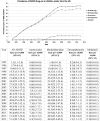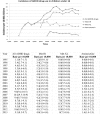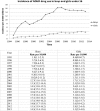Latest trends in ADHD drug prescribing patterns in children in the UK: prevalence, incidence and persistence
- PMID: 27297009
- PMCID: PMC4932306
- DOI: 10.1136/bmjopen-2015-010508
Latest trends in ADHD drug prescribing patterns in children in the UK: prevalence, incidence and persistence
Abstract
Objectives: To investigate attention deficit and hyperactivity disorder (ADHD) drug prescribing in children under 16 years old in the UK between 1992 and 2013.
Methods: All patients under 16 registered in the Clinical Practice Research Datalink (CPRD) with a minimum of 1 year of observation time and who received at least one prescription of any ADHD drug between 1 January 1992 and 31 December 2013.Trends in prevalence and incidence of use of ADHD drugs in children were calculated between 1995 and 2013 and persistence in new users was estimated.
Results: The prevalence of ADHD drug use in children under 16 increased 34-fold overall, rising from 1.5 95% CI (1.1 to 2.0) per 10 000 children in 1995 to 50.7 95% CI (49.2 to 52.1) per 10 000 children in 2008 then stabilising to 51.1 95% CI (49.7 to 52.6) per 10 000 children in 2013. The rate of new users increased eightfold reaching 10.2 95% CI (9.5 to 10.9) per 10 000 children in 2007 then decreasing to 9.1 95% CI (8.5 to 9.7) per 10 000 children in 2013. Although prevalence and incidence increased rather steeply after 1995, this trend seems to halt from 2008 onwards. We identified that 77%, 95% CI (76% to 78%) of children were still under treatment after 1 year and 60% 95% CI (59% to 61%) after 2 years.
Conclusions: There was a marked increase in ADHD drug use among children in the UK from 1992 until around 2008, with stable levels of use since then. UK children show relatively long persistence of treatment with ADHD medications compared to other countries.
Keywords: Medication trends; Medication use; attention deficit and hyperactivity disorder; attention deficit and hyperactivity disorder drugs; paediatric mental health.
Published by the BMJ Publishing Group Limited. For permission to use (where not already granted under a licence) please go to http://www.bmj.com/company/products-services/rights-and-licensing/
Figures





References
-
- Wold Health Organisation. International Statistical Classification of Diseases and Related Health Problems 10th Revision Secondary International Statistical Classification of Diseases and Related Health Problems 10th Revision 1997.
Publication types
MeSH terms
Substances
Grants and funding
LinkOut - more resources
Full Text Sources
Other Literature Sources
Medical
